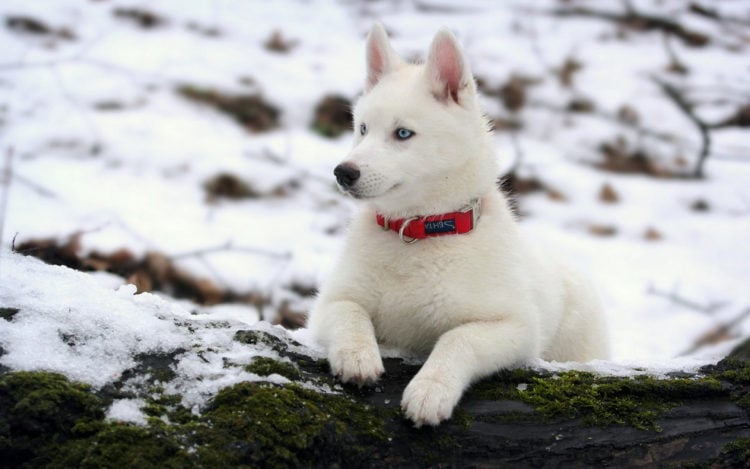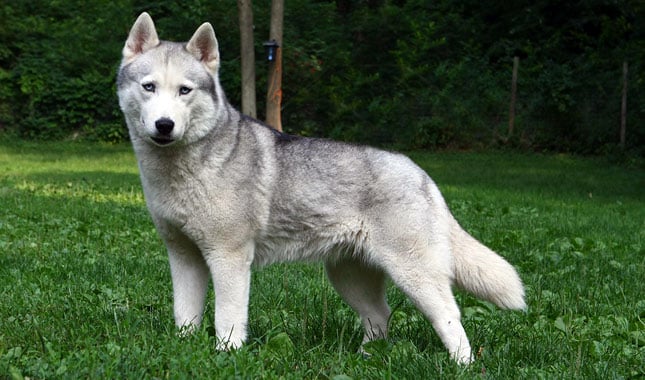10 Things You Didn’t Know about the White Siberian Husky

Siberian Huskies are one of the most beautiful breeds of dogs there is. They are beautiful to look at with their piercing eyes and thick, beautiful fur. When most people see a Husky, they immediately think of cold weather and sleds, that is because Huskies hail from the northern territories where they were primarily used to pull sleds. Huskies are built for cold weather, speed and endurance. When they first came into existence in the late 1800’s, they were used by the Native Americans, but eventually migrated into American territories and were trained to pull mail sleds, due to their ability to go long distances in the cold and snow. They are strong, agile, and determined dogs and love to work. Typically, there are two distinct breeds of Siberian Huskies; the long-distance and the sprinting breeds, and each were used for their specific duties. Here are ten things you didn’t know about the Siberian Husky breed.
1. How the Husky breed got noticed
Siberian Huskies made their first sled-team-pull in 1909 in the All Alaska Sweepstakes Race. It was this race that started the Siberian Husky trend in Northern America. Sled race enthusiasts began breeding the huskies and the breed quickly began to show their ability to be race winners. In 1925, Huskies were used to pull sleds to deliver medical supplies to ailing areas throughout Nome, Alaska during a diphtheria outbreak. The pack of dogs travelled over 600 miles in a short period of time, with the lead dog, Balto, running the last leg of the journey himself. He was honored with a statue in New York’s Central Park. People realized the strength and endurance of the breed and in 1930, The American Kennel Club gave their recognition as a breed. During World War II, Huskies were used for search and rescue. Soon after, the popularity of Huskies took off. They soon began to turn-up in homes all across the US, to be kept as domestic pets.
2. Can be difficult to train
Huskies may be strong and determined, which are good qualities to have during work time, however, it is their determined spirit that can make them difficult to train. Huskies have a will of their own and some people may find it hard to get them to be obedient. They are notorious for escaping out of fences, screen doors, garages and other areas. They should be supervised and not left alone for periods of time, and they need to have training start immediately as young pups. Training should be strict and consistent in order to develop a well-behaved Husky.
3. Heavy shedder
Huskies have thick, thick fur. Because they are bred for sled dogs in extreme temperatures, this means they develop thick undercoats to help keep them warm. Every year they will shed their undercoat and this can be messy. Huskies require heavy, regular grooming in order to keep them free of problems with their fur, and their skin. They should be brushed thoroughly every day to remove loose fur, however, Huskies are a breed that clean themselves. This is a nice trait for those who don’t have the time to bathe a dog on a regular basis. Baths are only needed when they get extremely dirty, otherwise, they are typically a clean and odor-free breed of dog.
4. Siberian Huskies use their tail for warmth
Huskies have a couple unique physical characteristics that make them able to withstand colder temps than the average dog. While most people think the tail of a dog is just a cute appendage that is used to show the dog’s mood; wagging it when he’s happy and excited, or hiding it when he’s nervous or scared. Huskies use their tail for reasons other than mood expression. In the extreme temperatures that Huskies were bred for, protecting their body parts is important. Huskies have big, bushy tails that they use to cover their feet and noses to protect them from the cold. They also have a different make-up of blood vessels in their legs and feet, than other dogs. The unique way the blood vessels run in a Husky’s feet and legs helps to prevent frostbite when they’re on the snow and ice.
5. High jumpers
Huskies are known to be high jumpers. If you plan to let your dog roam the backyard, it is a good idea that you make sure your Husky is secure in the yard. One way people secure their dog in a yard is with a fence. This is good for most dogs, however, Huskies are amazing jumpers and just any fence will not keep your Husky in your yard. Huskies can jump to extreme heights, even from a sitting position. The are also known diggers. Most often, a 6 feet tall fence will keep your Husky in the yard, unless there are items around he can use to climb and propel himself over. You will want to secure the bottom of the fence as well, and watch for problems with digging to escape.
6. Not good being off the lead
When out and about with your Husky; at the park, the beach or anywhere you think you can let your Husky roam and play, you may want to consider the fact that once off the lead, you may have trouble getting your Husky to listen and come back to you. Huskies are notorious for investigating. When they get a sight or smell in their head, they quickly become fixated and will be off and running. This is a common characteristic among the whole breed and not just your dog, so keeping your Husky on a lead at all times is the best way to keep him under your control.
7. Huskies howl
A lot of people buy big dogs for added protection for their homes. If nothing more than to have a ferocious sounding bark to scare off possible intruders. If you are considering a Husky as a pet to use as a form of protection, you may want to think of a different breed. Yes, Huskies are big, but no, they are not the best dog breed for home protection. Due to their sweet disposition, Huskies are more likely to befriend an intruder. They are also not big barkers, but rather, they like to howl. If you plan to get a Husky, be prepared to hear your Husky do a lot of communicating with you by means of howling.
8. Big dogs but not big eaters
You would expect that a big dog like a Husky would eat you out of house and home. Surprisingly, Huskies are not big eaters. Huskies can live on smaller amounts of food compared to other breeds their size. They’re also fuzzy eaters. If you own a Husky, you may notice that he turns up his nose at his food for a few days before he decides he’s hungry enough to eat.
9. Not a good couch potato dog
Some big breeds of dogs do just fine as a house or apartment dog. Huskies are not built to lay around a small home or apartment all day, so do not make good dogs for small, or inactive living environments. Huskies need lots of room to roam and exercise. If you are looking for a large, couch-potato dog to lounge with, a Husky is probably not the breed for you.
10. Not always good with other, smaller pets
Huskies have a sweet disposition but this is not necessarily true with every creature. Huskies have a tendency to want to dominate other animals, especially smaller animals. Huskies tend to obsess on other animals, like cats, hamsters, cats, and birds. Even if these pets are kept in cages, Huskies tend to focus on, and obsess, about the animal. They can be relentless on the animal and create a real nuisance for the household. Huskies may not be the best choice for intermixing other pets in your household, if you are looking for a dog to add to the mix.




